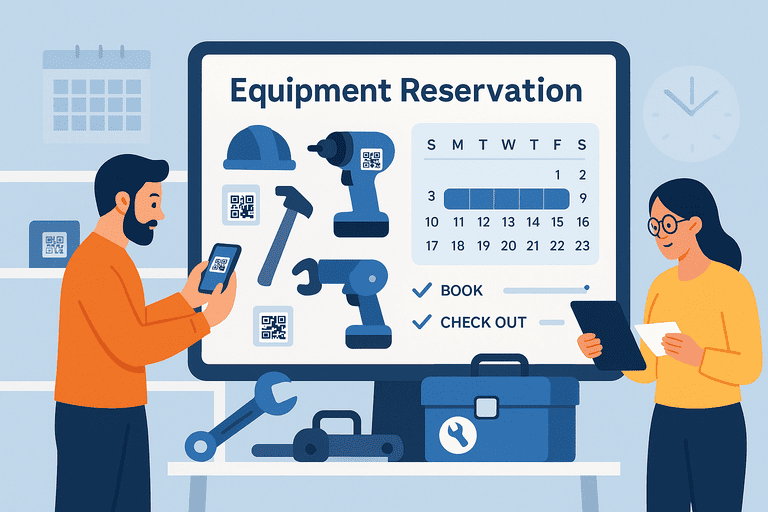Equipment Reservation Systems: Rules and Best Practices
Learn how to create effective equipment reservation systems that prevent double-booking, increase accountability, and improve asset utilization.

Introduction
When multiple employees or teams share tools, laptops, cameras, or vehicles, chaos can quickly arise without clear scheduling rules.
An equipment reservation system brings structure and visibility to shared resources — ensuring fair access and accountability.
In this guide, we’ll explore how to design and maintain a scalable reservation process, whether for office gear, lab instruments, or field equipment.
1. What Is an Equipment Reservation System?
An equipment reservation system allows users to book, check out, and return shared items through a centralized platform.
It replaces manual sign-out sheets or spreadsheets with automated scheduling and tracking.
Such systems help:
- Avoid double-booking and conflicts
- Maintain a digital log of asset usage
- Link equipment to users for accountability
- Optimize utilization and reduce idle time
2. Why It Matters for Shared Workplaces
From coworking spaces to universities, shared environments depend on efficient asset sharing.
Without a structured process, organizations face:
- Overlapping reservations causing friction between teams
- Unreturned or misplaced items due to unclear responsibility
- Limited visibility into who used what and when
- Maintenance neglect when no usage history exists
A reservation system centralizes access control and usage tracking — saving time, money, and frustration.
3. Essential Features of a Good Reservation System
1. Real-Time Availability View
Users should instantly see which equipment is booked, available, or under maintenance.
A calendar or list view makes scheduling intuitive.
2. User Authentication
Each reservation should be tied to a verified user or employee ID.
This ensures traceability and responsibility for asset condition.
3. Time-Based Rules
Allow configurable booking durations (e.g., hourly, daily, or weekly) and automatic restrictions based on availability.
4. Approval Workflows
For high-value or critical equipment, reservations should trigger manager or admin approval.
5. Check-In/Check-Out Scanning
Link physical QR or barcode scans to the reservation record, confirming pickup and return times.
6. Notifications and Reminders
Send alerts before pickup, during active use, and before due return to avoid delays.
7. Conflict Prevention
Automatically block overlapping reservations for the same asset.
8. Reporting
Track usage frequency, popular items, overdue returns, and total utilization per asset or category.
4. Rules for Smooth Operation
| Rule | Purpose | Implementation Tip |
|---|---|---|
| Define Booking Limits | Prevent hoarding | Max duration per user or per week |
| Require Returns Confirmation | Ensure availability for others | QR scan or admin validation |
| Set Grace Periods | Allow flexibility but track abuse | Mark frequent late returns |
| Enforce Maintenance Holds | Block assets under service | Automatic “unavailable” status |
| Enable Delegated Booking | Let managers book for team members | Assign permissions carefully |
| Require Comments or Purpose | Adds context for usage analysis | Useful for compliance reporting |
Consistency and automation make rules easy to follow — and harder to misuse.
5. Workflow Example
Here’s how a simple reservation flow might work:
- User logs in and views available items in a dashboard.
- Selects item (e.g., projector or laptop) and desired date/time.
- System checks conflicts and requests approval if necessary.
- Confirmation received — user gets email or app notification.
- At pickup, user scans QR code to confirm checkout.
- At return, system updates asset status and logs usage details.
All steps are recorded for transparency and audit readiness.
6. Best Practices for Long-Term Success
A. Centralize All Shared Resources
Don’t split equipment across separate booking tools.
A unified view ensures consistency and prevents forgotten assets.
B. Tag Everything
Even small items should have a unique ID or QR tag to tie usage logs to physical assets.
C. Automate Reporting
Generate weekly utilization and overdue reports to identify bottlenecks.
D. Maintain Usage History
Link each reservation to the user, timestamp, and condition — this helps with accountability and predictive maintenance.
E. Communicate Rules Clearly
Publish short “Reservation Guidelines” to set expectations on duration, return times, and responsibilities.
7. Measuring Efficiency
Evaluate your system’s performance using these metrics:
| Metric | What It Shows |
|---|---|
| Utilization Rate (%) | How often equipment is booked vs idle |
| On-Time Return Rate | Reliability of users |
| Overdue Assets Count | Potential compliance or workflow issues |
| Reservation-to-Use Ratio | Measures if bookings are completed or canceled |
These KPIs ensure your reservation system stays efficient and fair.
8. Integration Opportunities
To maximize value, connect reservation data with:
- Calendar tools (Outlook, Google Calendar)
- Inventory systems for live availability
- Slack or Teams for booking confirmations
- Accounting tools to calculate equipment cost per use
Integrations automate communication and eliminate manual coordination.
Conclusion
Equipment reservation systems keep shared assets organized, fair, and fully utilized.
They bring transparency to bookings, automate accountability, and simplify management for both admins and users.
With the right structure and rules, even the busiest shared environments can maintain smooth equipment sharing — without chaos.
Explore related asset-sharing topics: